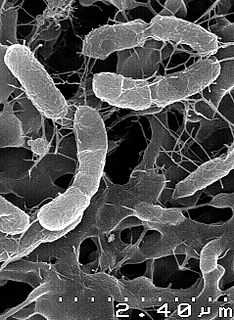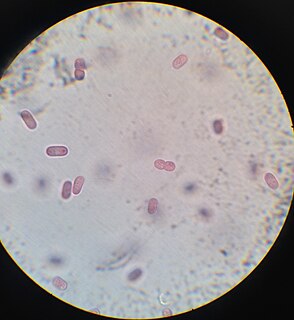Related Research Articles

Photosynthesis is a process used by plants and other organisms to convert light energy into chemical energy that, through cellular respiration, can later be released to fuel the organism's activities. Some of this chemical energy is stored in carbohydrate molecules, such as sugars and starches, which are synthesized from carbon dioxide and water – hence the name photosynthesis, from the Greek phōs, "light", and synthesis, "putting together". Most plants, algae, and cyanobacteria perform photosynthesis; such organisms are called photoautotrophs. Photosynthesis is largely responsible for producing and maintaining the oxygen content of the Earth's atmosphere, and supplies most of the energy necessary for life on Earth.

Otto Heinrich Warburg, son of physicist Emil Warburg, was a German physiologist, medical doctor, and Nobel laureate. He served as an officer in the elite Uhlan during the First World War, and was awarded the Iron Cross for bravery. He was the sole recipient of the Nobel Prize in Physiology or Medicine in 1931. In total, he was nominated for the award 47 times over the course of his career.

In biochemistry, chemosynthesis is the biological conversion of one or more carbon-containing molecules and nutrients into organic matter using the oxidation of inorganic compounds or ferrous ions as a source of energy, rather than sunlight, as in photosynthesis. Chemoautotrophs, organisms that obtain carbon from carbon dioxide through chemosynthesis, are phylogenetically diverse. Groups that include conspicuous or biogeochemically-important taxa include the sulfur-oxidizing Gammaproteobacteria, the Campylobacterota, the Aquificota, the methanogenic archaea, and the neutrophilic iron-oxidizing bacteria.

Chloroflexus aurantiacus is a photosynthetic bacterium isolated from hot springs, belonging to the green non-sulfur bacteria. This organism is thermophilic and can grow at temperatures from 35 °C to 70 °C. Chloroflexus aurantiacus can survive in the dark if oxygen is available. When grown in the dark, Chloroflexus aurantiacus has a dark orange color. When grown in sunlight it is dark green. The individual bacteria tend to form filamentous colonies enclosed in sheaths, which are known as trichomes.

Chlamydomonas reinhardtii is a single-cell green alga about 10 micrometres in diameter that swims with two flagella. It has a cell wall made of hydroxyproline-rich glycoproteins, a large cup-shaped chloroplast, a large pyrenoid, and an eyespot that senses light.

The Chromatiaceae are one of the two families of purple sulfur bacteria, together with the Ectothiorhodospiraceae. They belong to the order Chromatiales of the class Gammaproteobacteria, which is composed by unicellular Gram-negative organisms. Most of the species are photolithoautotrophs and conduct an anoxygenic photosynthesis, but there are also representatives capable of growing under dark and/or microaerobic conditions as either chemolithoautotrophs or chemoorganoheterotrophs.
Artificial photosynthesis is a chemical process that biomimics the natural process of photosynthesis to convert sunlight, water, and carbon dioxide into carbohydrates and oxygen. The term artificial photosynthesis is commonly used to refer to any scheme for capturing and storing the energy from sunlight in the chemical bonds of a fuel. Photocatalytic water splitting converts water into hydrogen and oxygen and is a major research topic of artificial photosynthesis. Light-driven carbon dioxide reduction is another process studied that replicates natural carbon fixation.
Eugene Rabinowitch (1901–1973) was a Russian-born American biophysicist who is known for his work in photosynthesis and nuclear energy. He was a co-author of the Franck Report and a co-founder in 1945 of the Bulletin of the Atomic Scientists, a global security and public policy magazine, which he edited until his death.
A photosynthetic reaction center is a complex of several proteins, pigments and other co-factors that together execute the primary energy conversion reactions of photosynthesis. Molecular excitations, either originating directly from sunlight or transferred as excitation energy via light-harvesting antenna systems, give rise to electron transfer reactions along the path of a series of protein-bound co-factors. These co-factors are light-absorbing molecules (also named chromophores or pigments) such as chlorophyll and pheophytin, as well as quinones. The energy of the photon is used to excite an electron of a pigment. The free energy created is then used, via a chain of nearby electron acceptors, for a transfer of hydrogen atoms (as protons and electrons) from H2O or hydrogen sulfide towards carbon dioxide, eventually producing glucose. These electron transfer steps ultimately result in the conversion of the energy of photons to chemical energy.
The photosynthetic efficiency is the fraction of light energy converted into chemical energy during photosynthesis in green plants and algae. Photosynthesis can be described by the simplified chemical reaction

Biohydrogen is H2 that is produced biologically. Interest is high in this technology because H2 is a clean fuel and can be readily produced from certain kinds of biomass.
Anastasios Melis is an American biologist at the University of California, Berkeley who elucidated the possibility of creating hydrogen from algae. He is currently Professor of Plant & Microbial Biology in the institution and Editor-in-Chief of the Planta journal.
Our Mr. Sun is a 1956 one-hour American television film in Technicolor written, produced, and directed by Frank Capra. It is a documentary that explains how the Sun works and how it also plays a huge part in human life. It was first broadcast on television by CBS in 1956.
Hiroshi Tamiya was an important Japanese plant biochemist and microbiologist. He is notable for mid-twentieth century research he did on the thermodynamics of the light-independent reactions of photosynthesis.

An autotroph or primary producer is an organism that produces complex organic compounds using carbon from simple substances such as carbon dioxide, generally using energy from light (photosynthesis) or inorganic chemical reactions (chemosynthesis). They convert an abiotic source of energy into energy stored in organic compounds, which can be used by other organisms. Autotrophs do not need a living source of carbon or energy and are the producers in a food chain, such as plants on land or algae in water. Autotrophs can reduce carbon dioxide to make organic compounds for biosynthesis and as stored chemical fuel. Most autotrophs use water as the reducing agent, but some can use other hydrogen compounds such as hydrogen sulfide.
Daniel Israel Arnon was a Polish-born American plant physiologist whose research led to greater insights into the operation of photosynthesis and nutrition in plants. In the first part of his professional career, the so-called "Plant Nutrition Years (1936-1950)", Arnon and collaborators discovered the essentiality of molybdenum for the growth of all plants and of vanadium for the growth of green algae. In the second one, the so-called "Photosynthesis Period (1951-1978)", plant micronutrient work led him to photosynthesis. In 1954, Arnon, Mary Belle Allen and F. Robert Whatley discovered photophosphorylation in vitro. Arnon served as president of the American Society of Plant Physiologists from 1952 to 1953.

Otto Kandler was a German botanist and microbiologist. Until his retirement in 1986 he was professor of botany at the Ludwig Maximilian University of Munich.
The evolution of photosynthesis refers to the origin and subsequent evolution of photosynthesis, the process by which light energy is used to assemble sugars from carbon dioxide and a hydrogen and electron source such as water. The process of photosynthesis was discovered by Jan Ingenhousz, a Dutch-born British physician and scientist, first publishing about it in 1779.

Hartmut K. Lichtenthaler is a German botanist, plant physiologist and university professor.

Mary Belle Allen was an American botanist, chemist, mycologist, algologist, and plant pathologist, and a pioneer of biochemical microbiology. With Daniel I. Arnon and F. Robert Whatley, she did breakthrough research discovering and demonstrating the role of chloroplasts in photosynthesis. In 1962 she received the Darbaker Prize from the Botanical Society of America for her work on microbial algae. In 1967 she was nominated jointly with Arnon and Whatley for a Nobel Prize.
References
- "Hydrogen metabolism of green algae: discovery and early research a tribute to Hans Gaffron"; Govindjee, J.T. Beatty, H. Gest, J.F. Allen. Discoveries in Photosynthesis Springer, 2006. ISBN 978-1-4020-3323-0, pp. 119–129
- "Hans Gaffron" in Reinhard Rürup, Schicksale und Karrieren: Gedenkbuch für die von den Nationalsozialisten aus der Kaiser-wilhelm-gesellschaft Vertriebenen Forscherinnen und Forscher, Wallstein Verlag, 2008. ISBN 978-3-89244-797-9